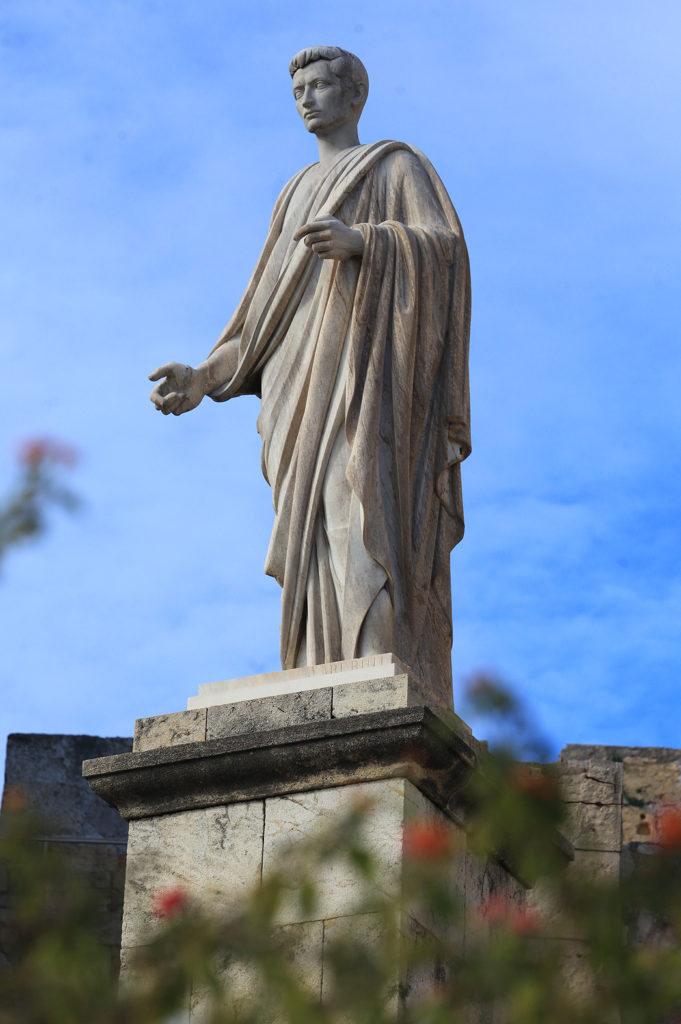Seen from the access stairs to the Pretorium Tower of Tarragona, the sculpture of Caesar Augustus (63ac-14dc), with the Mare Nostrum in the background, becomes majestic and full of symbolism.
No wonder the linkage between the Roman emperor and Tàrraco became extremely important for the city.
Despite his legacy not being immediate, the role of Tàrraco, in the context of the Empire, evolved, got stronger and experienced a growing on what its facilities and infrastructures were concerned.

An excellent climate, a location that provides protection from the Mediterranean winds, and its history connected to the Roman Empire.
These could have been key factors in the benefit of turning Tarraco into the residence of the Emperor.
Never before had a sovereign decided to live beyond the walls of the Empire’s capital city.
Caesar Augustus did so between 26 and 25BC, after an exhausting trip to Cantabria, where the climate got him sick.
Caesar Augustus and the Tarraco of the time
The Tàrraco that welcomed Caesar Augustus was erecting the Forum of the Colony and also, maybe, the Aqueduct (aka Pont del Diable).
While the Part Alta would have been the most probable location for a Roman camp. “Nobody can really tell where Caesar Augustus lodged”, says Magí Seritjol, manager of the Tàrraco Viva Festival.
However, it is said that he would have probably done so at the Part Alta.
Or even on a nearby village such as the vil·la dels Munts, in Altafulla, which would become home to the Emperor Adrian a few decades later.
Despite Caesar Augustus’s influence in Tarraco cannot be found directly on the construction of facilities or infrastructures.
Paco Tovar, historian and co-owner of the tourist guide company Argos Serveis Culturals, states that it is inevitable to attribute Tarraco’s transformation and improvement to the Emperor.
A crucial push which allowed several constructions such as the Amphitheatre, the Circus or the actual Temple of Augustus, below the surface of Tarragona’s Cathedral, to be brought to reality.
The legacy of Caesar Augustus is still very present in the city.
Celebrations around Caesar Augustus
Now, at the time of the second millennium of his death; a historical fact that arrives after years of restorations of Roman heritage in Tàrraco.
Some work is developed, mostly by the Tàrraco Viva Festival, in order to make the history and the role the Roman society had onto our culture widely known.
It is actually Tàrraco Viva, due next May by means of a commemorative special edition, which has created a program that will try to divulge and rediscover the leading figure of Caesar Augustus.
“He was an enthralling emperor in the public sphere –he ruled the Empire for four decades-, but also in terms of the society, the culture…” Magí Seritjol points out.
Meanwhile, highlights the personage “and how he was bewitched by masks and they way he would use them on a daily basis working as a politician and on his personal relationships”.
The mysticism
Now, if you want to find out more about Caesar Augustus other than stones, the historian Paco Tovar dares.
States that the “cult towards Caesar Augustus has been present in the city’s history every 23rd September –Santa Tecla’s Festivity-, and also on 19th August –day of his death-, time when Tarragona holds the so-called Sant Magí’s small festivity”.
Two dates, two coincidences?
Tovar says “it could be that Christians were in search of an excuse to celebrate the Roman culture”.
Answering to the same question, Seritjol smiles and adds, “Who knows? Maybe…”
Either way, Augustus is still seducing two thousand years after his death.
And there is no doubt he will continue being responsible for many stories that, just like curious tourists, we’ll be forced to follow.
This is why we are going to be following the steps of Augustus every month this year on the Tarragona Experience Blog.
And we’ll do it with a number of reports that will bring light to this exciting character, this politician; but above all, these reports will make us have a good time by means of his relation with the history of this city.
Written by Gemma Casale (@casalesi at Instagram)
Translated by: Artur Santos
Pictures: Pere Toda



